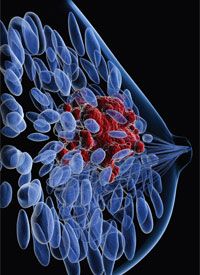Survival Benefit Hinted at With Durvalumab Maintenance in TNBC
Maintenance durvalumab may improve outcomes versus chemotherapy in patients with triple-negative breast cancer or those with PD-L1–positive breast cancer across several subtypes, according to exploratory analyses from the phase II randomized SAFIR02-IMMUNO trial presented at the 2019 San Antonio Breast Cancer Symposium.
breast cancer

Maintenance durvalumab (Imfinzi) may improve outcomes versus chemotherapy in patients with triple-negative breast cancer (TNBC) or those with PD-L1—positive breast cancer across several subtypes, according to exploratory analyses from the phase II randomized SAFIR02-IMMUNO trial presented at the 2019 San Antonio Breast Cancer Symposium (SABCS).
Among patients with TNBC (n = 82) in the SAFIR02 trial, the median overall survival (OS) was 21 months (95% CI, 16.6-27) with maintenance durvalumab compared with 14 months (95% CI, 9-16.3) with chemotherapy (HR, 0.54; 95% CI, 0.30-0.97; P = .0377). In those with PD-L1—positive disease across several breast cancer subtypes (n = 44), the median OS was 26 months with durvalumab (95% CI, 15–not reached) compared with 12 months (95% CI, 6.3–not reached) with chemotherapy (HR, 0.42; 95% CI, 0.17-1.05; P = .0552).
“This study generates the hypothesis that durvalumab as a single agent could improve outcomes in metastatic TNBC,” said lead study author Florence Dalenc, MD, lnstitut Claudius Regaud, IUCT-O, Toulouse, France.
In the overall “mixed” study population of patients with various breast cancer subtypes, survival results with durvalumab versus chemotherapy were similar. The median OS was 21.7 months (95% CI, 18.6-27.3) with immunotherapy compared with 17.9 months (95% CI, 14-24) with chemotherapy (HR, 0.84; 95% CI, 0.54-1.29; P = .42).
The data Dalenc presented at SABCS included 190 patients accrued to the SAFIR02 trial. Patients had locally advanced or metastatic breast cancer and were required to be HER2-negative, although there were 2 HER2-positive patients enrolled on the trial. Patients with ER-positive disease had to have progressed on endocrine therapy.
Patients were required to have received first- or second-line chemotherapy. Additionally, patients could not have a targetable molecular alteration and had to achieve a complete or partial response or stable disease following 6 to 8 cycles of chemotherapy, or 4 cycles for those with toxicity-related discontinuation.
In a 2:1 ratio, patients were randomized to durvalumab at 10 mg/kg every 14 days, or maintenance chemotherapy without switch. Maintenance chemotherapy options included paclitaxel, capecitabine, and FEC.
The median age was 56 in both arms, and about 60% of patients in each arm had an ECOG performance status of 0. About half of patients in each arm had liver metastases and about 25% had lung metastases. Around 40% of patients in each arm had ≥3 sites of metastasis. In the durvalumab arm, 37.6% of patients had TNBC, 60.8% of patients had HR-positive/HER2-negative disease, and 1.6% of patients were HER2-positive. The corresponding rates were 52.2%, 47.8%, and 0% in the control arm.
PD-L1—positive status was defined as a ≥1% expression level as measured by the SP142 assay. In the durvalumab arm, 32.6% of patients were PD-L1–positive compared with 34% in the control arm. Around 90% of patients in each arm had received frontline chemotherapy, with 39.7% and 42.6% of patients achieving an objective response to induction chemotherapy in the immunotherapy and control arms, respectively. Among patients with TNBC, 52.4% were PD-L1–positive, compared to 14.9% in patients without TNBC.
Maintenance durvalumab did not improve progression-free survival (PFS) in the overall population. The median PFS was 2.7 months (95% CI, 2.1-3.6) with the PD-L1 inhibitor as compared with 4.6 months (95% CI, 2.6-5.7) with chemotherapy (HR, 1.40; 95% CI, 1.00-1.96; P = .047). The hazard ratio for PFS favored maintenance chemotherapy in most predefined patient subgroups. However, the hazard ratio favored durvalumab in patients with TNBC (HR, 0.87; 95% CI, 0.54-1.42) and in PD-L1—positive patients (HR, 0.75; 95% CI, 0.38-1.49).
Dalenc specifically noted the lack of a benefit with durvalumab over chemotherapy in patients with hormone receptor—positive metastatic breast cancer (HR, 2.08; 95% CI,1.28-3.40; P = .0025).
Regarding safety, grade 3/4 treatment-related adverse events (AEs) occurred in 13.2% and 15.9% of the durvalumab and control arms, respectively. Treatment-related serious AEs occurred in 8.5% versus 1.6%, respectively. AE-related treatment discontinuation occurred in 6.2% versus 9.5% of the immunotherapy versus chemotherapy cohorts, respectively. There were no AE-related deaths.
Going forward, in addition to teasing out the potential benefit of durvalumab in TNBC, the researchers also plan to use multiplexed pathology analyses of tissue samples from SAFIR02 to determine what parameters limit response to immunotherapy in patients with HR-positive metastatic breast cancer. They also hope to focus on potential combination approaches that could yield effective results with immunotherapy in these patients.
Dalenc F, Bachelot T, Fllleron T, et al. Durvalumab compared to maintenance chemotherapy in patients with metastatic breast cancer: Results from phase II randomized trial SAFIR02-IMMUNO. Presented at: 2019 San Antonio Breast Cancer Symposium; December 10-14; San Antonio, TX. Abstract GS3-02.



